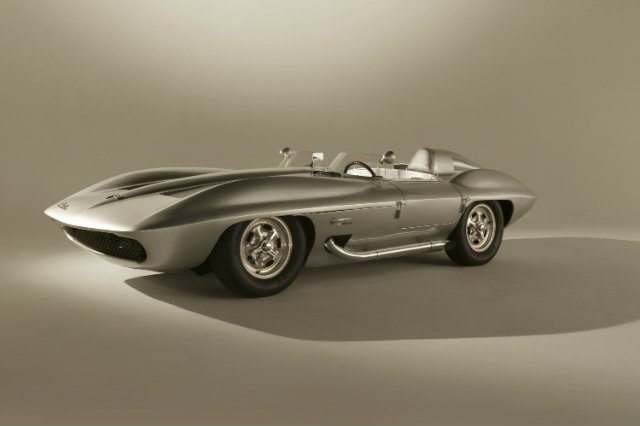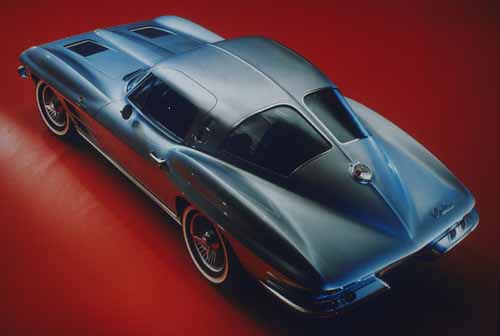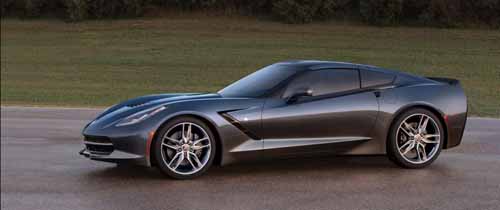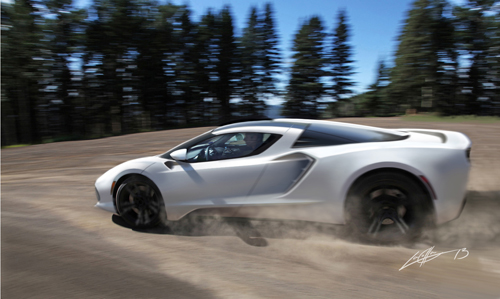THE AUTOEXTREMIST
 Monday, January 21, 2013 at 03:06PM
Monday, January 21, 2013 at 03:06PM January 23, 2013
Marketing the Corvette: What GM doesn’t get.
By Peter M. De Lorenzo
(Posted 1/22, 5:30 p.m.) Detroit. Now that the smoke has cleared (somewhat) from the frenzy of the Detroit Auto Show – and the big bang debut of the new Corvette – it’s time to take a hard look at Corvette from a brand image and marketing point of view.
As I’ve said repeatedly in this column, there are only two cars (and car names) in modern American automotive history that qualify as true icons in this business, the Chevrolet Corvette and the Ford Mustang. Around for 60 and 50 years, respectively, the Corvette and the Mustang transcend all others because of their evocative imagery and indisputable status as America’s two brightest automotive lights. The true test? Even non-car people know what a Mustang and a Corvette are. Even more, they can conjure these two cars in their own historical image banks and can instantly remember an experience when they saw one for the first time or rode in one in their formative years.
But dealing with that kind of iconic status isn’t easy for Ford and GM. Half the battle revolves around knowing what you have and understanding its place in the automotive universe. That might sound simple but believe me it isn’t. Executives with – ahem – varying degrees of competence who have been given the marketing reins for these cars have come and gone over the years, and battles have ensued and mistakes have been made, but the ball more or less has kept moving forward for these two icons despite the occasional egregious missteps. It can't be overstated that it has taken tremendous effort by the True Believers involved in order to maintain the focused consistency that these nameplates deserve.
In Ford’s case, the F-150 may be The Franchise, but the Mustang is the heart and soul of the company. And I can assure you that as much time is spent on not screwing it up or sending it down the wrong path as there is time spent on marketing the car. Or thinking about the next Mustang that’s in the works.
When you consider what the Mustang means to the Ford Motor Company, you can understand why Ford executives, members of the Ford family and employees throughout the company take the nameplate so seriously. And it's why you'll never see them phoning it in or treating the Mustang lightly or as an afterthought.
But of course at General Motors, we're talking a completely different situation with the Corvette. To be sure, to the True Believers within GM's product development and design functions, the Corvette is every bit as important as the Mustang is to Ford. To them the Corvette is the heart and soul of the company as well.
The difference between the two companies gets wildly pronounced when considering how upper management views the Corvette at GM. In the early years the Corvette was on the chop list more than once. Students of this industry are already familiar with the monumental battles between the True Believers like Harley Earl, Zora Duntov and Bill Mitchell, and the "suits" at GM who not only didn't get the car but couldn't be bothered one way or the other. That the Corvette has survived in the hostile environment created by the vacuous bean counter-driven "culture" - or at least what passes for one - at General Motors is a small miracle unto itself.
Were there bad years for the Corvette? Absolutely. The mid- to late-70s was an embarrassing period. (Same for the Mustang, as a matter of fact.) But the car survived that and even intermittently thrived. And in recent years, thanks to the committed engineers and designers - and the exceptional Corvette Racing program - Corvette is viewed with a notable measure of respect by competing manufacturers and enthusiast consumers alike.
And here we are today with a brand-spanking-new-generation Corvette, so things should be all right with the world, right? You would think so but despite all of the hoopla surrounding the new Corvette's launch, and all of the glowing words coming from within GM (Captain Queeg's comments not withstanding) and from the assembled media, the same black cloud hovers over the Corvette that has always been there.
And that ominous looking black cloud is one of indifference.
How can that be, you say? Everyone at the Detroit Show representing GM seemed to be switched on about the new Corvette, right? Yes, this is true. At least the people who matter within GM, that is. But the cloud of indifference I'm talking about is big and nasty and hangs in the air like a bad dream. And it's best exemplified by the prevailing attitude of GM upper management that ultimately the Corvette sells itself, and now that they've committed the funding for the development and launch of the C7, they can move on to other, more important things.
Let me amplify this cloud of indifference for you. When the Corvette Racing program started to deliver wins in the GT class in the 24 Hours of Le Mans over the last fourteen years, the wins were almost invisible except to the racing media and the enthusiast consumers who deemed it important. Why? Because it was like pulling teeth to get GM marketers to tout the accomplishments. Oh, you'd see an occasional race-win ad here or there, but nothing on the order of how a Chevrolet win in NASCAR is promoted.
Yes, it should be pointed out that recently GM has gotten better at image wrangling when it comes to the Corvette, but can you imagine what another manufacturer would do if they had an icon like the Corvette in their product portfolio? Can you imagine if it were a German auto company that owned the Corvette? Can you imagine how those racing wins at Le Mans would be used? I daresay you wouldn't be able to move without seeing or hearing mention of them.
And therein lies the point. Any other manufacturer would use the Corvette as the tip of its technological spear. A race win at Le Mans would mean an instant social media blast and double-truck newspaper spread ads in every major newspaper in the country. (And on the day after the race, too, not ten days later when the print media buy was more advantageous.) But to upper management at GM? Remember, the Corvette sells itself. The attitude can be distilled to this: why invest money in something that's a niche, something we don't sell that many of to begin with? I can't think of a more egregious example of people doing less with more in this business than what GM has done - or hasn't done - with Corvette. It's a complete travesty when it comes right down to it.
And, as if it needs to be pointed out, that is why, despite their protestations to the contrary, GM marketers not only don't get the Corvette, they don't even know where to begin to understand how to fix it. I would say that is a major problem. To have an iconic vehicle with the status of the Corvette and not know what to do with it is tantamount to being Porsche and not knowing how to market the 911.
So I'm going to lay out a marketing and product plan for the Corvette that would propel it at top speed into the pantheon of the elite sports cars in the world. No more "it's fantastic for the money" excuses. No more mismanagement or non-management decisions to hold the Corvette back. In short, a plan to properly - and finally - nurture one of the iconic cars in the world.
You can't get there from here.
I've heard the argument almost since the day I was born: "We put a little bit of Corvette in all of our Chevys." It's simple, lure them into the showroom with the Corvette, and sell them a (insert Chevy model name here). The idea that a halo car will sell your other products is as old of an axiom that there is in this business. But that axiom has clearly run its course when it comes to Corvette and Chevrolet. Especially now that Chevrolet is going global with a mixture of funky-fun small cars that have a completely different mission. What does Corvette have to do with Chevrolet when it really comes right down to it? Nostalgia? That doesn't count for much in this, the most competitive market in automotive history. Chevrolet should go ahead and chase its newly energized global mission with glee. But the Corvette deserves a higher plateau to aim for.
The first order of business?
Make Corvette a brand unto itself. Enough already with the familial resemblance to other Chevrolets that seems to be all of a sudden important on the C7 with its Camaro-esque taillights. It's silly and flat-out stupid when it comes right down to it. If GM can position Cadillac and Chevrolet as global bands, then the Corvette deserves to be a global brand too. The Europeans who flock to Le Mans aren't interested in Chevrolet anything, but they are interested in Corvette, and anything and everything to do with Corvette. You don't think that the Corvette as a stand-alone brand would have resonance globally? Think again. Just because the power of the Corvette name has been underutilized up until now, that doesn't mean it can't be polished into something much more.
The second order of business?
Besides relocating the Corvette brand headquarters as far away from GM's RenCen headquarters as I could get it, I would completely and thoroughly upend the Corvette product portfolio, from top to bottom. Instead of multiple variations of one Corvette, I would have three Corvettes. (I'd like to thank Josiah LaColla for his scintillating and imaginative illustrations, by the way) The new Corvette lineup would look like this:
 (Digital illustration by Josiah LaColla, © 2013 Autoextremist.com http://lacolladesign.blogspot.com)
(Digital illustration by Josiah LaColla, © 2013 Autoextremist.com http://lacolladesign.blogspot.com)
The 2016 Corvette Stingray.
1. The 2016 Corvette Stingray. Not to be confused with the current car, this will be the entry level Corvette that the non-boomers are clamoring for. And no, you won't find any reptilian nightmare design influences here either. Imagine a car with a footprint longer, wider and lower than the discontinued Solstice/Sky twins but with a fresh design that would harken back to the original Sting Ray (the name was two words back then), with Corvair Monza SS concept overtones. Available in a roadster only (that means no hardtop, removable or otherwise), this car would have a Twin-Turbo V6 with 375HP, 7-speed manual (only) gearbox, 50-50 weight distribution, a driving dynamic profile tuned to aggressive-fun and a target curb weight of 2,800 pounds. And round taillights, of course. Price? $39,995 base. And with minimal option packages available it would come in at $49,995, fully loaded.
 (GM)
(GM)
The magnificent '59 Corvette Sting Ray was a stunning design statement in its time, and it still resonates with the Corvette faithful and automobile enthusiasts today.
 (GM)
(GM)
The 1963 Corvette Sting Ray is still considered to be one of the all-time great American production cars.
 (GM)
(GM)
The all-new 2014 Corvette.
2. The 2016 Corvette SS. This would be the newly-introduced C7 with about 25 percent of the overwrought and overdone surface detailing removed. A complete rethink of the side vents and associated detailing would be undertaken, moving the car away from its vaguely Nissan GT-R overtones and more in keeping with great Corvettes of the past. And the back end would be completely redesigned to include round taillights and a more subtle seductiveness, without compromising its GT racing mission. This would still be the mainstream Corvette, one that the Corvette faithful would be very happy with on a day-in, day-out basis.
 (Digital illustration by Josiah LaColla, © 2013 Autoextremist.com http://lacolladesign.blogspot.com/)
(Digital illustration by Josiah LaColla, © 2013 Autoextremist.com http://lacolladesign.blogspot.com/)
The 2018 mid-engined Corvette Chaparral.
3. The 2018 Corvette Chaparral. Yes, you read that correctly. The Corvette Chaparral. This is the car that the Corvette faithful have been clamoring to have for decades. This would be a clean-sheet, mid-engined Corvette for the ages, with Jim Hall's blessing, of course. This machine would boast every ounce of GM technological know-how plus every current and future trick in the book available. Carbon fiber chassis and body structure with the use of advanced technical materials throughout. Twin-Turbo, Direct-Injected 800HP LT1 V8 with hybrid assist and rear-biased all-wheel-drive. Ten-speed dual range sequential automatic. Extremely limited production cadence of 1000 vehicles over a 42-month build sequence. No excuses and no "what ifs." The Corvette Chaparral would have it all and then some. Price point? $175,000. Its stated mission beyond, of course, giving Corvette enthusiasts their ultimate fantasy? To kick Audi, BMW, McLaren and Porsche's ass at Le Mans and deliver the first overall win for an American manufacturer there since 1969.
This product portfolio would accomplish several things. First of all it would put to rest the undeliverable notion that one Corvette can be adjusted to skew younger. That's notgonnahappen. But you can do an entry-level Corvette that would address that idea elegantly and emotionally, while adhering to the legacy of one of the all-time great cars: the original '59 Sting Ray. Secondly, it would give the Corvette - now Corvette SS - some breathing room to be better. Abandoning some of the surface hand-wringing and cleaning up its overwrought details, its design presence would blossom and it would fulfill its role as the car that the Corvette aficionados would savor and relish for years to come. And finally, the Corvette Chaparral would put the new global brand Corvette on the map. A car that would be mentioned with the other super cars of the world as a matter of fact, not as a matter of surprise.
As I've stated previously, this image-wrangling business as it applies to automobiles is serious stuff. And when it is applied to iconic vehicles like the Corvette and the Mustang, the ramifications go up exponentially.
GM has mishandled and all but squandered the Corvette image for going on decades, and it would be comical if it weren't so pathetic and sad. The company overlords need to finally treat the Corvette properly. And that doesn't mean paying attention to it when it's time to do a new one, it means nurturing the brand Corvette on a daily if not hourly basis. It means using the brand as the tip of the technological spear for the entire company, not as a marketing afterthought that you only address when convenient or absolutely necessary.
Turning the Corvette into a global brand while removing it from its more mundane Chevrolet shackles is exactly what is needed, but it won't happen under Dan Akerson's watch. It's completely over his head and besides, he wouldn't understand the script even if it was pounded into him. He would of course understand the profitability potential, but remember, this is the guy who said the new Corvette is the most beautiful car GM has ever produced. It's fair to say he wouldn't know the second-best one.
But I personally know two high-level GM executives who know exactly what I'm talking about and who would sign up for this Corvette program in a second. It would require the kind of focused consistency – and serious cash – that GM has only dreamed of up until now, but I have tremendous confidence in the True Believers hard at work on the Corvette program that they could deliver this enhanced mission in spades.
The Corvette deserves better. Much better. Here's to the idea of a future for Corvette that exceeds even my most colorful imagination.
And that's the High-Octane Truth for this week.
See another live episode of "Autoline After Hours" with hosts John McElroy, from Autoline Detroit, and Peter De Lorenzo, The Autoextremist, and guests this Thursday evening, at 7:00PM EDT at www.autolinedetroit.tv.
By the way, if you'd like to subscribe to the Autoline After Hours podcasts, click on the following links:
Subscribe via iTunes:
http://itunes.apple.com/WebObjects/MZStore.woa/wa/viewPodcast?id=311421319
Subscribe via RSS:
http://www.autolinedetroit.tv/podcasts/feeds/afterhours-audio.xml







